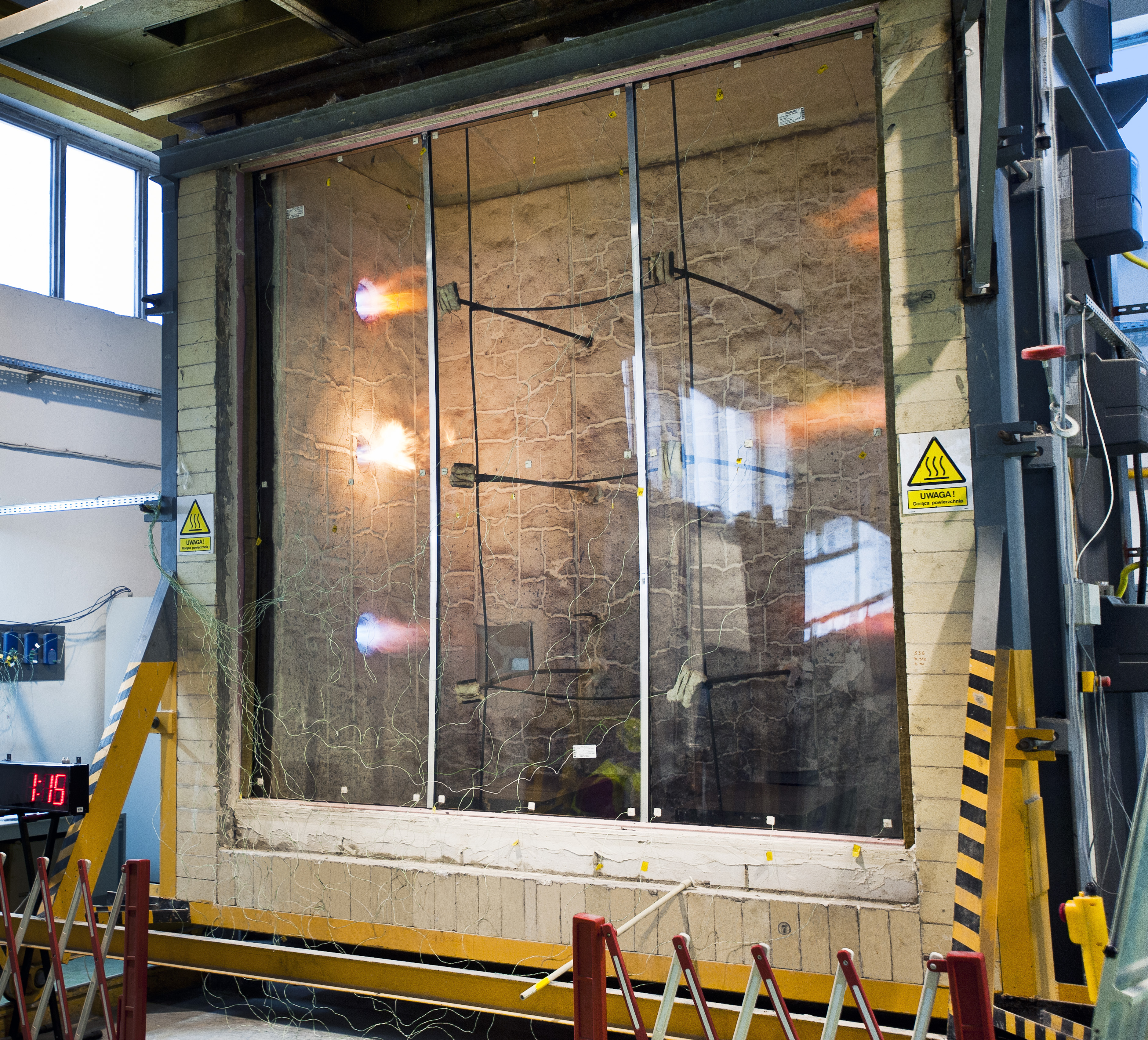Ensuring safety in buildings is of the utmost importance, especially in places where a lot of people stay at the same time. One of the main safety issues is proper fire safety that is guaranteed, among others, by the use of proper materials. This includes construction materials, but also glass, which is now being increasingly used in many establishments, in order to replace walls.
The resistance of a single glass sheet to temperature increase is small – after a few minutes it breaks and then becomes completely destroyed. Therefore, all glazed elements of a building where a class of fire resistance is required must be made of fire-resistant glass. There are various technologies of manufacturing fire-resistant glass, and one of them is glass where a layer of special gel is placed in-between glass sheets. One such product is fire-resistant POLFLAM EI 120 glass – which is entirely transparent, since the gel inside does not reduce the translucency of glazing. Whereas, during a fire this gel becomes dull, then hardens, and forms an efficient barrier against flames and a high temperature.
When protection is needed
The legal regulations applicable in Poland expressly state that each building must be designed and constructed in a manner that the spread of flames and smoke in its interior is reduced if a fire breaks out. And, as a result, certain elements of a building, including partition walls, doors and other partitions, must withstand fire thrust and very high temperatures. However, it is easy to imagine that full protection is not feasible; therefore,
a specific building element must withstand a fire for a time period assumed by a designer.
In the case of internal partitions, apart from load bearing walls, two characteristics are taken into account i.e. fire integrity (E) and insulation (I). The resistance of a partition is specified in classes that take into account a time during which a particular element does not catch fire. An average temperature at its surface may not rise by more than 140 °C, and at any chosen place – by more than 180°C respectively. The only question is for how long this element will withstand such an intensive temperature increase. Now we have to get back to previously mentioned classes of fire resistance. In the determination of these classes it is time which is of the greatest importance. El 120 glass must withstand fire for at least two hours – and that is a long time.
It is worth knowing that from the side of a raging fire it is gradually damaged, while on the other side a person can safely come up very close to a window pane. Consequently, people and property are safe; they have time to evacuate themselves from the building or wait until the rescue services arrive. Fire-resistant glass must be manufactured in accordance with applicable laws. Currently, the applicable standard criteria set out for fire insulation is PN-EN 1363 -1 “Testing of fire insulation”. However, before it reaches a customer and a specific building, it undergoes detailed tests confirming its characteristics. POLFLAM EI 120 glass is firstly tested at a factory laboratory, similarly to all its equivalents with a different fire resistance. Here, it is worth mentioning that, as a rule, the time of exposing glass to fire and fire conditions is longer than it is required according to a specific class of glass. The point is that the customer must be sure that the procedure the whole glazing must undergo at a certified testing entity is not open to unpleasant surprises.

At the factory laboratory fire-resistant glass undergoes such tests as those performed later
at a certified testing entity (Photo: POLFLAM)
Window pane as any other?
Fire-resistant POLFLAM El120 glass only slightly differs from a standard double-glazed window pane. Similarly to standard glass it comprises of two glass sheets, a spacer bar and a classic two-step edge joint. However, whereas inside a typical double-glazed window-pane there is air or noble gas, high-temperature resistant glass has a special, colourless hydrogel there. It is this thickness of its layer that is decisive in terms of a time during which the window pane will be resistant to a fire. It is not hard to imagine that a glass resistance degree depends on the thickness of a gel layer, although it is not the only one relation.
In case of POLFLAM EI 120, the thickness of glass is mere 35 mm, and one square metre of glass weighs 57 kg, whereas products of other manufacturers are 52-58 mm thick and weigh between 108 and 122 per square metre respectively. It is an unquestionable ace up the local manufacturer’s sleeve and it gives them a market edge, but also makes them a technological leader in this market segment. The gel thickness – as we have previously mentioned – does not reduce the translucency of glass. The light penetrability ratio reaches 85.5%, whereas a relatively large thickness of a window pane positively affects sound reduction – the Rw ratio (C-1; Crt-4) may reach 45 dB. Moreover, the glass is resistant to UV radiation, contact with water, and ensures a higher class of fire protection: 1/B/1 determined pursuant to PN-EN 12600 standard. Such fire-resistant glazing is also very resistant to mechanical damage. Owing to the use of hardened glass, flexible window panes may be manufactured, and that is another advantage of the technology used by the company. Fire-resistant POLFLAM EI 120 glass has several applications – it is used, among others, in aluminium and steel joinery and woodwork. It may also be used in certain type of walls as frameless glazing (gypsum and cardboard, masonry and others).
With the use of POLFLAM EI 120 glass, company FR Solutions (www.frsolutions.pl) proposes such solutions. They are in high demand by both architects and developers as well as investors because they offer the possibility to construct huge, aesthetic, brilliant and transparent fire-resistant partitions.
